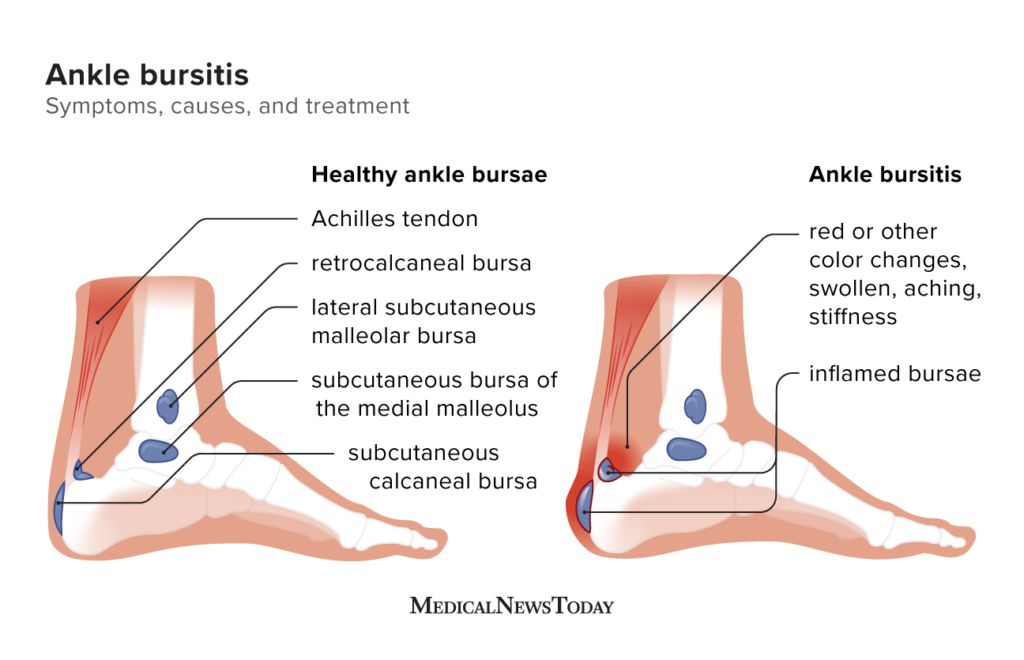Ankle bursitis occurs when one or more of the bursae sacs in the ankle become inflamed. This can cause pain, swelling, and difficulty moving the ankle.
Bursae are small, fluid-filled sacs throughout the body. They typically develop where bones, tendons, and muscles rub against one another.
Bursae act as cushions, helping to reduce friction and prevent damage to the tissues around the joints during movement. They also contain synovial fluid, which lubricates the joints and helps reduce wear and tear on the joint surfaces.
This article will discuss the symptoms, causes, and treatment options for people with ankle bursitis.

Ankle bursitis is when one or more of the bursae in the ankle become inflamed or irritated due to overuse or injury.
The Arthritis Foundation notes that common symptoms of ankle bursitis include:
- pain and tenderness in the ankle
- swelling or a lump in the ankle
- stiffness or difficulty moving the ankle
- extra warmth around the ankle
- redness or other skin color changes around the affected area
- aching or throbbing in the ankle, especially when a person applies pressure
These symptoms can vary in severity depending on the cause and extent of the inflammation.
Read about bursitis.
According to the American College of Rheumatology, there are several common causes of ankle bursitis, including:
- Overuse: Overuse or repetitive motion of the ankle joint, common in runners or dancers, can irritate the bursae and cause inflammation.
- Trauma: Trauma to the ankle, such as from a fall or injury, can damage the bursae and lead to inflammation.
- Infection: Infection in the bursae, although rare, can cause ankle bursitis.
- Medical conditions: According to the Arthritis Foundation, certain medical conditions, such as gout or rheumatoid arthritis, can increase the risk of developing ankle bursitis.
- Inappropriate footwear: Versus Arthritis notes that wearing poorly fitting shoes that put pressure on the ankle can also contribute to developing ankle bursitis.
Learn about the difference between bursitis and arthritis.
- doing jobs that require making repetitive movements
- performing activities or hobbies that involve repetitive movements
- not warming up before exercising
- developing an infection in or near the ankle joint
- having certain health conditions, such as:
- obesity
- rheumatoid arthritis
- osteoarthritis
- gout
- systemic lupus erythematosus
- scleroderma
- spondyloarthropathy
Avoiding these risk factors can help prevent bursitis.
To diagnose ankle bursitis, a healthcare professional will
In some cases, doctors may also order imaging tests, such as an X-ray or MRI, to rule out other conditions and assess the extent of the inflammation.
If a doctor suspects that an infection is causing bursitis, they may also order a fluid sample from the bursae to test for bacteria or other pathogens.
Once the doctor confirms a diagnosis of ankle bursitis, they will develop a treatment plan tailored to the individual’s specific needs.
Treatment for ankle bursitis varies depending on its severity, the underlying cause, and the individual’s overall health. Common
- resting the affected ankle and avoiding activities that aggravate the condition
- applying ice to the affected area to reduce swelling and pain
- taking anti-inflammatory medications such as ibuprofen or naproxen, which help reduce inflammation and pain
- wearing supportive shoes or orthotics to reduce pressure on the ankle
- performing physical therapy exercises to strengthen the ankle muscles and improve flexibility
- receiving injections of corticosteroids or other medications into the bursae to reduce inflammation
- in rare cases, undergoing surgery to remove the inflamed bursae or repair damage to the ankle joint
People need to consult a doctor if they suspect they have ankle bursitis. A doctor can diagnose the condition and develop a treatment plan. In some cases, a combination of treatment options may be necessary.
People can manage their ankle bursitis and lessen their symptoms with the right treatment.
If people do not avoid the trigger for ankle bursitis, the condition can reoccur and lead to long-term joint damage or chronic pain.
With proper care and management, most people with ankle bursitis can expect to recover fully and return to their everyday activities.
Ankle bursitis is when one or more of the bursae in the ankle become inflamed, causing pain, swelling, and difficulty moving the ankle.
Overuse, trauma, infection, or underlying medical conditions are common causes of ankle bursitis. Treatment options include resting the ankle, taking anti-inflammatory medication, physical therapy, and surgery.
With proper treatment and management, most people with ankle bursitis can recover fully and return to their typical activities.


